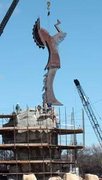Pipelines and/or transmission are the choke point of energy policy. Getting energy from there to here is a big problem. Wind energy is useless if there is no transmission to get it to market. This summer, the Bonneville Power Authority is periodically disconnecting wind power from its grid. (See "Tilting at Windmills" in the Economist.) Why? There is so much excess melt water that the Authority is giving away hydro power for free and even paying utilities the cost of getting that power from there to them. Unfortunately there is not enough transmission to fully share the Pacific Northwest's bounty with the rest of America. Hence the idle windmills. Ludwig von Mises's ghost must be experiencing schadenfreude as it mutters "another triumph for socialist planning!"
Natural Gas coming out of the ground does little good unless it can be captured and transported to markets. So what do you do if you find natural gas way out at sea? Your project is in deep water economically and financially (pun intended) and will thus be dead in the water because you can not get the gas to market. (Sorry.)
John R. Hays, Jr. is fond of reminding me how high tech the oil and gas industry is. Shell now gives us more evidence of just high tech it is. Six hundred engineers from around the world have worked on the world's first floating liquefied natural gas facility (FLNG). Watch the video below to learn about the development phase of the Prelude FLNG Project to define, design and evaluate plans for the facility. They built a scale model of the FLNG facility and tested it in tanks in artificial marine conditions to see if it would withstand wind and high waves. The plan is to capture gas from a field far off of Broome, Western Australia, liquify it at sea, and ship the liquified natural gas (LNG) to markets.


